人教版九年级英语Unit 6 When was it invented 教案
- 格式:doc
- 大小:144.50 KB
- 文档页数:24
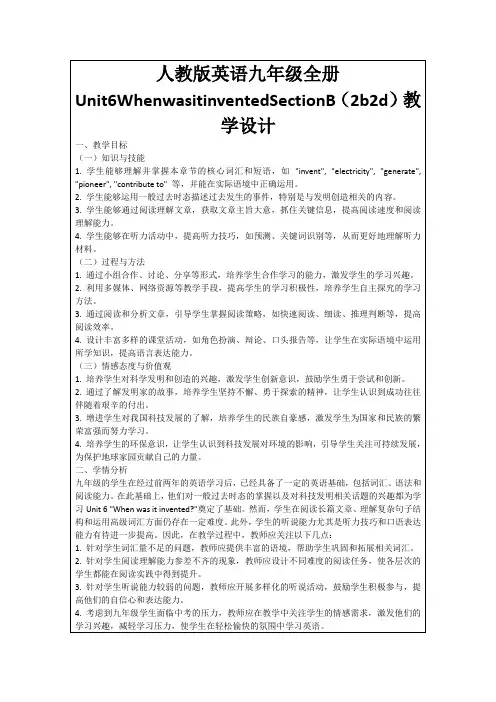
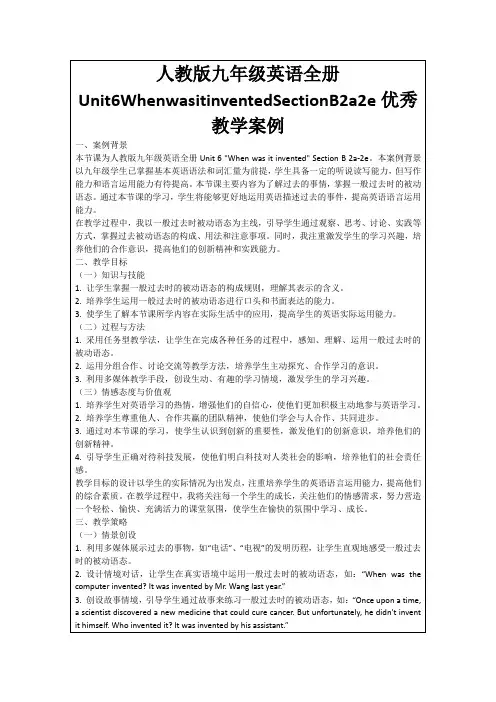

人教版九年级英语《Unit 6 When was it invented?》Section B教学设计1一. 教材分析人教版九年级英语《Unit 6 When was it invented?》Section B主要介绍了与发明和创新相关的内容。
本节课的主要语言点是过去式的被动语态,学生需要通过学习了解过去式的被动语态的构成和用法。
同时,本节课还涉及到一些与科技发展相关的词汇和表达方式,如:telephone, television, computer, Internet等。
本节课的话题贴近学生的生活,能够激发学生的学习兴趣和积极性。
二. 学情分析九年级的学生已经掌握了基本的英语语法和词汇知识,具备一定的听说读写能力。
但是,对于过去式的被动语态,部分学生可能还不太熟悉,需要通过练习来巩固。
此外,学生对于科技发展的了解程度不同,需要在课堂上进行适当的引导和拓展。
三. 教学目标1.知识目标:学生能够掌握过去式的被动语态的构成和用法,正确运用过去式的被动语态进行表达。
2.能力目标:学生能够听懂、会说、会读、会写与科技发展相关的词汇和表达方式。
3.情感目标:学生能够激发对科技创新的兴趣,增强对科技发展的认识。
四. 教学重难点1.重点:过去式的被动语态的构成和用法。
2.难点:过去式的被动语态在实际语境中的运用。
五. 教学方法1.任务型教学法:通过完成各种任务,激发学生的学习兴趣,提高学生的参与度。
2.情境教学法:创设各种情境,帮助学生理解和运用过去式的被动语态。
3.交际法:通过小组讨论、角色扮演等形式,提高学生的口语表达能力。
六. 教学准备1.教学PPT:制作与本节课相关的内容,包括文本、图片、视频等。
2.教学材料:准备与科技发展相关的小故事或新闻,用于拓展学生的知识面。
3.录音设备:用于播放听力材料。
七. 教学过程1.导入(5分钟)利用图片或视频展示一些科技创新的例子,如:智能手机、无人机等。
引导学生谈论这些科技产品,激发学生的学习兴趣。
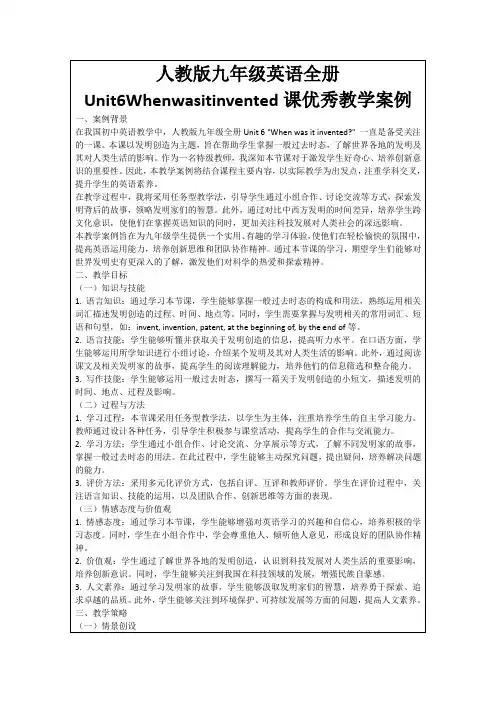
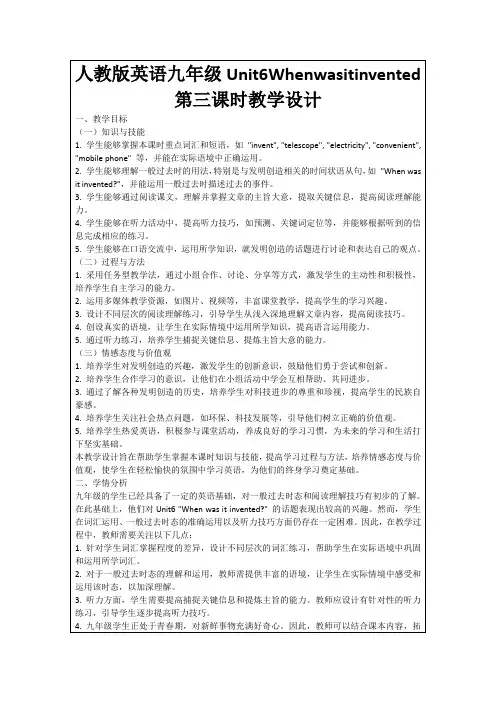
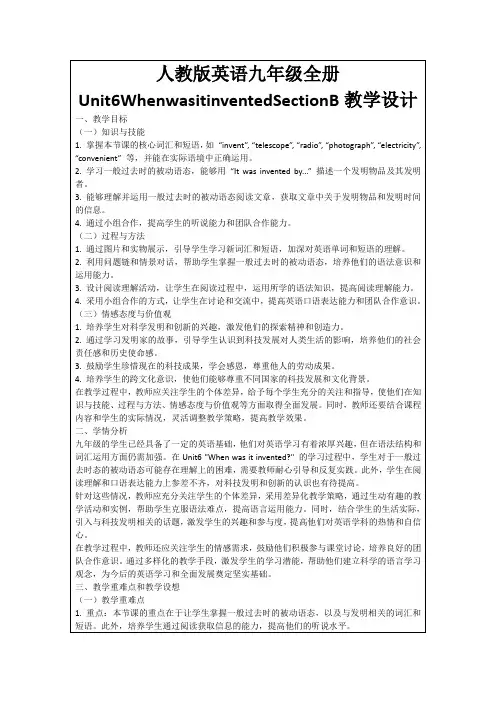
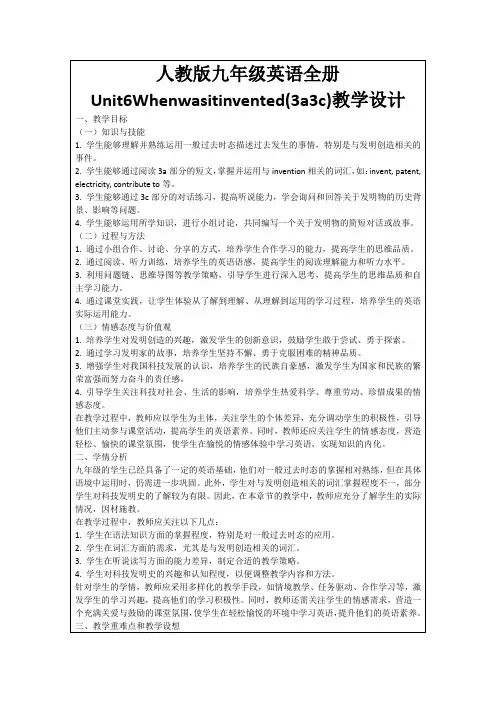
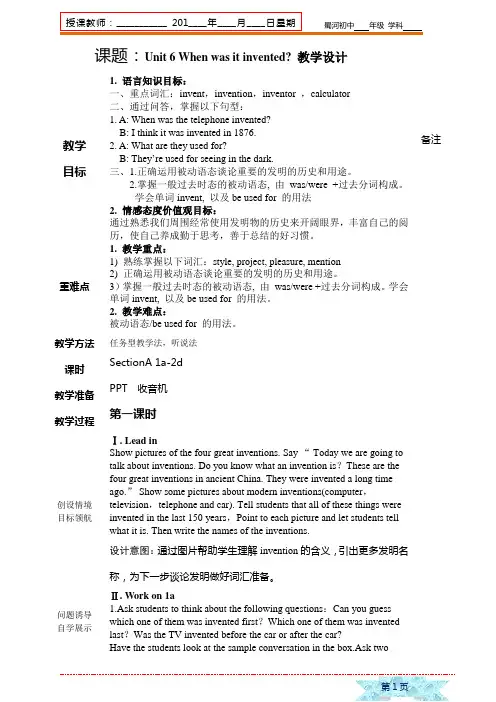
课题:Unit 6 When was it invented? 教学设计教学目标1. 语言知识目标:一、重点词汇:invent,invention,inventor ,calculator二、通过问答,掌握以下句型:1. A: When was the telephone invented?B: I think it was invented in 1876.2. A: What are they used for?B: They’re used for seeing in the dark.三、1.正确运用被动语态谈论重要的发明的历史和用途。
2.掌握一般过去时态的被动语态, 由was/were +过去分词构成。
学会单词invent, 以及be used for 的用法备注2. 情感态度价值观目标:通过熟悉我们周围经常使用发明物的历史来开阔眼界,丰富自己的阅历,使自己养成勤于思考,善于总结的好习惯。
重难点1. 教学重点:1) 熟练掌握以下词汇:style, project, pleasure, mention2) 正确运用被动语态谈论重要的发明的历史和用途。
3)掌握一般过去时态的被动语态, 由was/were +过去分词构成。
学会单词invent, 以及be used for 的用法。
2. 教学难点:被动语态/be used for 的用法。
教学方法任务型教学法,听说法课时SectionA 1a-2d 教学准备PPT 收音机教学过程第一课时创设情境目标领航Ⅰ. Lead inShow pictures of the four great inventions. Say “ Today we are going to talk about inventions. Do you know what an invention is?These are the four great inventions in ancient China. They were invented a long time ago.” Show some pictures about modern inventions(computer,television,telephone and car). Tell students that all of these things were invented in the last 150 years,Point to each picture and let students tell what it is. Then write the names of the inventions.设计意图:通过图片帮助学生理解invention的含义,引出更多发明名称,为下一步谈论发明做好词汇准备。
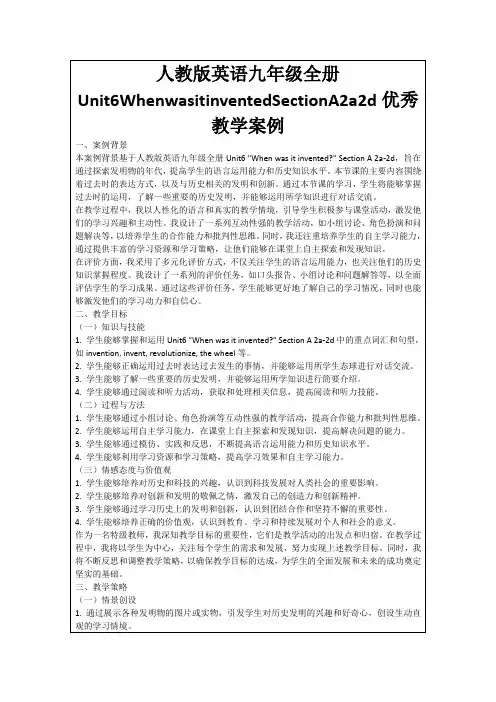
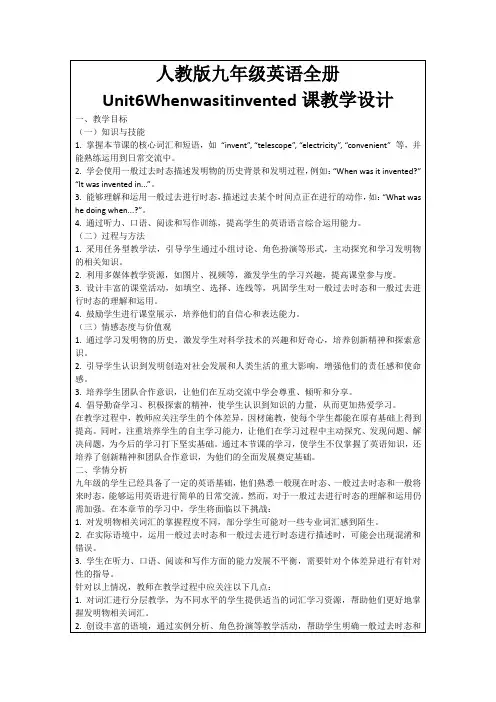
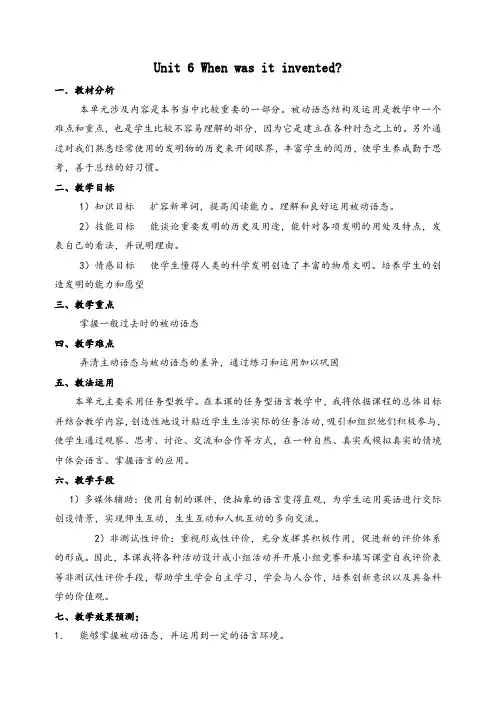
Unit 6 When was it invented?一.教材分析本单元涉及内容是本书当中比较重要的一部分。
被动语态结构及运用是教学中一个难点和重点,也是学生比较不容易理解的部分,因为它是建立在各种时态之上的。
另外通过对我们熟悉经常使用的发明物的历史来开阔眼界,丰富学生的阅历,使学生养成勤于思考,善于总结的好习惯。
二、教学目标1)知识目标扩容新单词,提高阅读能力。
理解和良好运用被动语态。
2)技能目标能谈论重要发明的历史及用途,能针对各项发明的用处及特点,发表自己的看法,并说明理由。
3)情感目标使学生懂得人类的科学发明创造了丰富的物质文明。
培养学生的创造发明的能力和愿望三、教学重点掌握一般过去时的被动语态四、教学难点弄清主动语态与被动语态的差异,通过练习和运用加以巩固五、教法运用本单元主要采用任务型教学。
在本课的任务型语言教学中,我将依据课程的总体目标并结合教学内容,创造性地设计贴近学生生活实际的任务活动,吸引和组织他们积极参与,使学生通过观察、思考、讨论、交流和合作等方式,在一种自然、真实或模拟真实的情境中体会语言、掌握语言的应用。
六、教学手段1)多媒体辅助:使用自制的课件,使抽象的语言变得直观,为学生运用英语进行交际创设情景,实现师生互动,生生互动和人机互动的多向交流。
2)非测试性评价:重视形成性评价,充分发挥其积极作用,促进新的评价体系的形成。
因此,本课我将各种活动设计成小组活动并开展小组竞赛和填写课堂自我评价表等非测试性评价手段,帮助学生学会自主学习,学会与人合作,培养创新意识以及具备科学的价值观。
七、教学效果预测;1.能够掌握被动语态,并运用到一定的语言环境。
2.通过多媒体和任务的完成学生会突破难点,产生一定创造精神。
3.能完成教学目标,调动学生学习热情。
八、课时安排:6课时九、教学程序Period One Section A 1 (1a-2d)一、教学目标:1. 语言知识目标:1) 能掌握以下单词: heel, scoop, electricity, style, project, pleasure, zipper,daily, website, pioneer, list, mention能掌握以下句型:①—When was the telephone invented?—I think it was invented in 1876.②—What are they used for? —They are used for seeing at night.2) 能谈论物品被发明的时间、发明者,表达某发明的用途。
人教版九年级英语《Unit 6 When was it invented?》Section A教学设计2一. 教材分析人教版九年级英语《Unit 6 When was it invented?》Section A主要介绍了与发明物相关的动词短语和一般过去时的被动语态。
本节课的主要内容包括三个部分:阅读文本、听力练习以及口语交流。
通过本节课的学习,学生能够掌握与过去相关的被动语态的运用,以及学会如何运用动词短语描述事物的发明时间。
二. 学情分析九年级的学生已经掌握了英语学习的基本语法和词汇,具备一定的阅读和听力能力。
但是,对于一般过去时的被动语态和与发明物相关的动词短语的运用,部分学生可能还存在一定的困难。
因此,在教学过程中,需要针对学生的实际情况进行针对性的教学。
三. 教学目标1.知识目标:学生能够掌握一般过去时的被动语态,以及与发明物相关的动词短语。
2.能力目标:学生能够运用所学的动词短语和被动语态进行简单的口语交流和写作。
3.情感目标:通过学习,学生能够增强对科技发展的兴趣和好奇心。
四. 教学重难点1.重点:一般过去时的被动语态的运用。
2.难点:与发明物相关的动词短语的运用。
五. 教学方法1.任务型教学法:通过设计各种任务,让学生在实践中学习和运用语言。
2.情境教学法:创设各种情境,让学生在真实的语境中学习和运用语言。
3.交际法:通过小组讨论和角色扮演等方式,让学生进行真实的交际。
六. 教学准备1.教师准备:备好相关的教学材料,如PPT、教案等。
2.学生准备:预习相关的词汇和语法知识。
七. 教学过程1.导入(5分钟)通过展示一些常见的发明物,如手机、电视等,引导学生谈论这些发明的出现时间,引出本节课的主题。
2.呈现(10分钟)通过PPT展示本节课的主要内容,包括一般过去时的被动语态和与发明物相关的动词短语。
让学生边看PPT边跟读,加强记忆。
3.操练(15分钟)设计一些简单的口语练习,让学生运用所学的动词短语和被动语态进行练习。
Unit 6 When was it invented?Section A教学设计科目:英语课题:Section A 课时:3课时教学目标与核心素养:语言能力:能够运用目标句型进行交际,清楚身边重要发明物的历史及用途。
文化意识:学生能够介绍了我们日常生活中一些常见物品的发明历史,谈论发明物的历史及用途,体会中华文化博大精深。
思维品质:能发现同类型语篇的相似之处和不同类型语篇的结构特征;能多角度、辩证地看待事物和分析问题。
学习能力:能整理、归纳所学内容,把握重点和难点;能主动反思自己英语学习中的进步与不足。
教学重难点教学重点:被动语态的结构和用法;谈论发明物的历史及用途。
教学难点:理解被动语态的功能和意义。
课前准备:多媒体,黑板,粉笔教学过程:一、LeadinginT:"Do you know Chinese four great ancient inventions?" to introduce the topic of this unit.二、Practice教学1a(1) Have students observe the pictures in 1a and guess the order of the four inventions(2) Have students group and discuss according to the activity requirements of 1a, and then sort the pictures.三、Listening教学lb1.Play the recording for the first time. Ask the students to write the era of each inventions.Then check the answers with the whole class.2. Play the audio of 1b again, students follow and imitate the conversation. The teacher requires students to pay attention to understanding the emotions of both parties in the conversation and the corresponding pronunciation and intonation.教学1cImitate the dialogue in 1c, use the information from 1b listening material to practice a new dialogue with peers, and invite several groups of students to perform the dialogue. 教学2a2d1. Play the tape for Ss to listen and number the inventions [13] in the order they hear them.2. Ss listen again and plete the chart.3. Listen again and fill in the blanks.4. Check answers.5. Work in pairs to make conversations using the information in 2b.6. Play the tape for Ss to listen and repeat.7. Work in pairs to role play the conversation in 2d.8. Make Ss read the conversation and answer the questions.9. Ask Ss to have a summary about the zipper.10. Work in pairs. Talk about the Top 10 inventions that changed the world.四、Reading教学3a3c1. Ss read the article quickly and match each paragraph with its main idea.2. Read the passage again and answer the questions.3. plete the sentences with the correct forms of the verbs in the box.五、Language Points1.It is said that a Chinese ruler called Shen Nong was the first to discover tea as a drink.据说是一位叫作神农的中国统治者最早发现茶可以饮用要点精析“It is said that从句”是含有that从句的一种复合句,形式主语是it,that引导的从句作真正的主语,意为“据说......”,相当于People say that...。
人教版九年级英语《Unit 6 When was it invented?》Section A教学设计1一. 教材分析人教版九年级英语《Unit 6 When was it invented?》Section A主要介绍了与日常生活相关的几个重要发明的年代。
本节课主要围绕过去时态进行描述,通过学习本节课,学生能够掌握一般过去时的构成和用法,以及如何用一般过去时描述过去发生的事情。
教材内容贴近生活,有利于激发学生的学习兴趣和积极性。
二. 学情分析九年级的学生已经掌握了基本的英语语法知识和一定程度的词汇量,具备一定的听说读写能力。
但部分学生对过去时态的掌握还不够扎实,需要在本节课中进一步巩固。
此外,学生对日常生活中的科技产品有一定的了解,但可能对一些历史悠久的发明不太熟悉,需要在课堂上进行引导和拓展。
三. 教学目标1.知识目标:–学会一般过去时的构成和用法。
–掌握本节课的重点词汇和短语。
–能够用一般过去时描述过去发生的事情。
2.能力目标:–提高学生的听说读写能力,尤其是听力和口语表达能力。
–培养学生的合作意识和团队精神。
3.情感目标:–激发学生对科技发展的兴趣,培养学生的创新意识。
–增强学生对国家科技历史的自豪感。
四. 教学重难点•一般过去时的构成和用法。
•本节课的重点词汇和短语。
•一般过去时在实际语境中的运用。
•对部分科技发明的了解和描述。
五. 教学方法1.任务型教学法:通过设定各种任务,激发学生的学习兴趣,培养学生的实践能力。
2.情境教学法:创设真实情境,让学生在实践中学习、巩固知识。
3.合作学习法:引导学生分组讨论、合作完成任务,提高学生的团队协作能力。
六. 教学准备1.教师准备:–制作课件和教学素材。
–准备相关科技发明的历史资料。
2.学生准备:–预习教材,了解本节课的基本内容。
–搜集一些科技发明的历史资料,以便课堂上分享。
七. 教学过程1.导入(5分钟)–教师通过提问方式引导学生复习一般现在时,为新课的学习做好铺垫。
Unit 6 When was it invented?Section A 1 (1a-2d)一、教学目标:1. 语言知识目标:1) 能掌握以下单词:heel, scoop, electricity, style, project, pleasure, zipper, daily,website, pioneer, list, mention能掌握以下句型:①—When was the telephone invented?—I think it was invented in 1876.②—What are they used for?—They are used for seeing at night.2) 能谈论物品被发明的时间、发明者,表达某发明的用途。
2. 情感态度价值观目标:了解一些近现代发明的时间及用途,激发自己热爱发明的情感。
培养想象力,善于观察事物。
面对难题,用积极的态度去解决,发挥想象力,认识世界,改造世界。
二、教学重难点1. 教学重点:1) 本课时的单词、词组和句型,学习运用一般过去时态的被动语态。
2) 学会询问发明时间及用途的基本句型:—When was the telephone invented?—I think it was invented in 1876.—What are they used for?—They are used for seeing at night.2. 教学难点:运用一般过去时态的被动语态来讨论发明的发明时间及用途。
三、教学过程I. Warming up1. 展示一些近代发明的图片与近代发明的发明者,让学生们将图片与发明者相连。
T: Do you know what these inventions are?S1: It’s a car.S2: It’s a telephone.S3: It’s a television.T: Do you know who these inventors are?S1: Karl BenzS2: Alexander BellS3: J. L. BairdLet Ss match the inventions and the inventors.Ⅱ. Presentation引导学生们学习一般过去时态的被动语态结构。
让学生们看大屏幕的如果爱和发明者的图片,并将句子改为被动语态。
如:T: Karl Benz invented the first car in 1885.The first car was invented (by Karl Benz) in 1885.Ⅲ. Talking1. Look at the pictures in 1a. Discuss with your group, in what order do you think they were invented? Try to number them [1-4].2. Ss discuss with their partners and number the pictures.3. Talking about the inventions:A: I think the TV was invented before the car.B: Well, I think the TV was invented after the TV.Ⅳ. Listening (1b)1. T: Tell Ss look at the pictures and years on the left.2. Play the recording for the Ss to listen.3. Ss listen to the conversation and try to match the invention with the proper year.4. Play the recording again.5. Check the answers.Ⅴ. Pair work (1c)1. Ss try to remember the invention and the year.2. Student B, cover the dates. Student A, ask Student B when the things in the picture in 1b were invented. Then change roles and practice again.3. Let some pairs ask and answer in pairs.e.g. A: When was the telephone invented?B: I think it was invented in 1876.…Ⅵ. Learning the new words & ListeningLook at the pictures then learn the new words.Work on 2a:T: Tell Ss they will hear some interesting inventions.1. Look at the pictures in 2a. Discuss the things what they are used for.2. Play the recording for the Ss to listen and number the pictures.3. Play the recording again to check the answers.Work on 2b:1. Let Ss read the chart below. Explain some main sentences for the Ss. Make sure they know what to do.2. Play the recording for the Ss to fill in the blanks.3. Play the recording again to check the answers.4. Listen again and fill in the blanks.Ⅶ. Pair work (2c)1. Tell Ss to make conversations using the information in 2b. Make a model for the Ss. A: What are the shoes with special heels used for?B: They are used for changing the style of the shoes.2. Let some Ss make conversations using the information in 2b.3. See which group does the best.Ⅷ. Role-play(2d)1. Read the conversations and Let Ss read after the teacher.2. Explain some new words and main points in the conversation.3. Ask Ss to role-play the conversation in groups.X. Language points1. Well, you do seem to have a point…have a point 有道理e.g. I admit (that) you have a point. 我承认你有理。
2. They are used for seeing in the dark.be used for doing sth.表示“被用来做某事”。
相当于be used to do sth.e.g. This computer is used to control all the machines.这台电脑是用来控制所有机器的。
Do you know what this tool is used for?你知道这工具是用于做什么的?3. Think about how often it’s used in our daily lives.think about 表示“考虑,想起”e.g. He is thinking about travelling in the summer holidays.他正在考虑暑假旅游的事。
She was thinking about her childhood days.她正回想她的童年时期。
【拓展有关think 其它的短语】think of 指“考虑,记忆,记起”如:You think of everything! 你全都提到了。
I can’t think of his name at the moment. 我一时想不起他的名字。
think sth. over指“仔细想,审慎思考,作进一步考虑”如:Please think over what I said.请仔细考虑我说的话。
I want to think it over. 我想仔细考虑一下这件事。
think sth. out 指“想通,想出,熟思”如:He thought out a new idea. 他想出了一个新主意。
That wants thinking out. 那件事需要仔细考虑。
HomeworkRecite the conversation in 2d.Section A 2 (3a-3c)一、教学目标:1. 语言知识目标:1) 学习掌握下列词汇:by accident, ruler, boil, remain, smell, saint, national,take place, doubt, without doubt2)阅读短文,能按要求找到相应的信息。
3)通过阅读提高学生们的阅读能力。
4) 了解茶叶被发明的历史及生产制作的简要过程。
2. 情感态度价值观目标:培养想象力,善于观察事物。
面对难题,用积极的态度去解决,发挥想象力,认识世界,改造世界。
二、教学重难点1. 教学重点:1) 掌握本部分出现的生词和词组,达到熟练运用的目标。
2) 阅读短文,获得相关的信息。
通过阅读练习,来提高阅读能力。
2. 教学难点:1) 阅读短文,获得相关的信息的能力。
2) 理解并运用所学的词汇及表达方式。
三、教学过程Ⅰ. Revision1. Check the homework.2. Role-play the conversation in 2d.Ⅱ. Lead-in一、播放视频《茶叶的起源》,让学生们了解中国的茶文化,及茶叶被发明的渊源,并了解其发展过程。